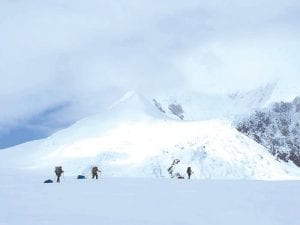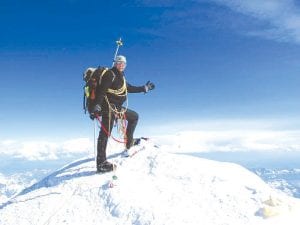Photos courtesy of Eric Larsen On July 2, 2009, Eric Larsen and two fellow mountaineers stood at the top of North America’s highest peak, Mount McKinley, otherwise known as Denali. Larsen’s climb was only preparation for an epic adventure starting this November – Larsen will attempt to be the first person to mount unsupported expeditions to the top, bottom, and roof of the world — North Pole, South Pole, and Mount Everest – within a continuous 365-day period. He is trying to raise awareness of ecological issues related to global warming. He says, “It’s cool to be cold. Save the poles, save the planet. Think snow.”

At 5:00 p.m. on July 2, 2009, Eric Larsen of Grand Marais and fellow mountaineers Ryan Waters and Mark Sheen stood at the top of Mt. McKinley, otherwise known as Denali, 20,360 feet above sea level in the middle of Alaska. “It was a beautiful, gorgeous view,” he said in an audio Internet podcast the next day.
For many adventurers, summiting Denali would be the peak of their mountain climbing experiences – almost half of those who have tried it have failed because of extreme weather and avalanche risk. For Larsen, however this was simply preparation for a climb up Mount Everest, the world’s highest peak.
Larsen is not planning for Mount Everest to be the peak of his experience, either. He is on his way to be the first person to mount unsupported expeditions to the top, bottom, and roof of the world—North Pole, South Pole, and Mount Everest—within a continuous 365-day period. His website, www.ericlarsenexplore.com, states that only 15 people have been to all three places, none of them Americans.
“The goal of this expedition,” Larsen’s website states, “is to document the last great frozen places left on the plant, promote ways to reduce carbon emissions, and increase awareness to help stop global warming. Equally important, the expedition serves as an inspiration to achieve the hopes and dreams within us all.”
Larsen arrived in Alaska June 23, only to wait in Talkeetna for the weather to clear so they could be flown in to base camp. It was 55 degrees and raining in Talkeetna but snowing and blowing at base camp. “You learn patience. There are things in this life that you can’t control,” Larsen said in his June 24 podcast.
The next day they were off, battling intense sun and heat at first, leading to near whiteout conditions and high winds over the next couple of days.
“It’s difficult to imagine the tectonics that created these jagged peaks,” Larsen said on his way up. “It is truly a pristine wilderness.” He doesn’t consider the earth’s ecosystem as rugged as the weather and the terrain on Denali, however, and never forgets his mission. “Only a few degrees temperature change separate the last major ice age from today’s planet,” he said. “…Big thoughts for tired climbers.”
Along the way, Larsen battled self-doubt, fatigue, and melancholy and missed his family and friends. He had faith in his companions, however. “No one of us is as strong as all of us,” he said.
Good weather prevailed overall. The seven-day climb brought them from base camp to summit about a week sooner than they had expected. The last day, they decided not to make a planned stop at 17,000 feet but kept going to the summit. The weather was good but not expected to stay that way.
At the top, they were tired and concerned about the second half of their trip – getting back down the mountain. Thatnight they ended up at 14,000 feet after 15 hours of climbing and hiking. They were careful, however. “We traveled across some pretty crazy terrain,” Larsen said, describing 1,000-foot drop-offs on either side.
“Even rest days can be work on an expedition,” Larsen had written June 18. “Don’t get me wrong, I love being on big expeditions and outside, but it’s important to realize that it’s no vacation. More often than not, it’s just plain hard work. It’s work that I wouldn’t trade for the world!”
Life after Denali has been interesting for Larsen as well. Doug Oppenheim and Jeremy Rodgers, with Larsen at the South Pole last year, were raising money to fight Lou Gehrig’s disease, and one of their patrons, the Duke of Devonshire (England) had all three over for dinner on July 22. “He wanted to host a dinner in honor of our ‘little foray’ (Doug’s very British description of a very difficult trip) to Antarctica,” Larsen wrote.
Larsen stayed in a castle the night before. He was asked to plan a few words for the occasion. “I’m not exactly sure what I’ll say,” he wrote, “but my life is pretty simple and uninteresting, so it might require a little creative brainstorming on the train ride. …How about this for an opener: ‘Well, back in Minnesota….’ A little too provincial, maybe. I’ll keep working on it.
“I am completely out of my league for sure and I feel a bit overwhelmed. But as so often happens with me these days, I simply move forward and hope for the best. I’m not always certain of the outcome of many situations in my life. So, I gather up what little courage I can muster, hold my breath and take one small step forward. Then another. And another. It’s slow progress, but eventually, the path, my small speech or whatever, becomes clear.”
In a blog he entitled “Penguin Suits,” Larsen shared some quotes from the evening (“things I don’t normally hear in a typical day”): “What is your favorite tapestry?” “Eric, you’ll be sitting next to the Duke.” “Don’t bump into the Renoir.” “Would you like more champagne, sir?” “Sir.” He included a photo of the evening “to actually verify the fact that I do sometimes wear clothes other than long underwear.”
Larsen has spent considerable time speaking on behalf of sponsors and trying to get more sponsors. “It’s hard to hear ‘no’ for an idea that you know in your heart is good and a cause that is important,” he wrote. “Protecting our environment (reducing carbon emissions) not only helps preserve the quality of life on our planet but also serves as smart business and a way to save money in this difficult economy.”
Larsen found himself giving presentations in Texas this August. “Went to Texas and got hot,” he wrote. “Crazy weather. Not really fitting for a polar explorer. Still, I can’t help but like extreme weather conditions.”
In a September 13 blog entitled “Thenot so exciting world of a polar explorer,” Larsen, who has been training in Colorado, talked about a recent visit to Minnesota. “I love Colorado, but I think Dorothy said it best, ‘There’s no place like home.’”
Larsen is philosophical about many aspects of his life and his adventures. Thissummer, he did not make it to his 20th high school class reunion, but he thought about the years between then and now. “Twenty years ago today, I was on a canoe trip with a couple of good friends down the St. Croix River in Wisconsin. …I remember looking up at the stars one night and wondering how my life would play out.. …Despite not being home for my reunion, I continue to meet old friends in odd places. …I like running into old friends and acquaintances. While I often laugh at who we were, I am always amazed at who we have become.”
In November, Larsen’s 365-day challenge begins with an expedition to the South Pole.
Larsen’s mantra: “It’s cool to be cold. Save the poles, save the planet. Think snow.”



Loading Comments